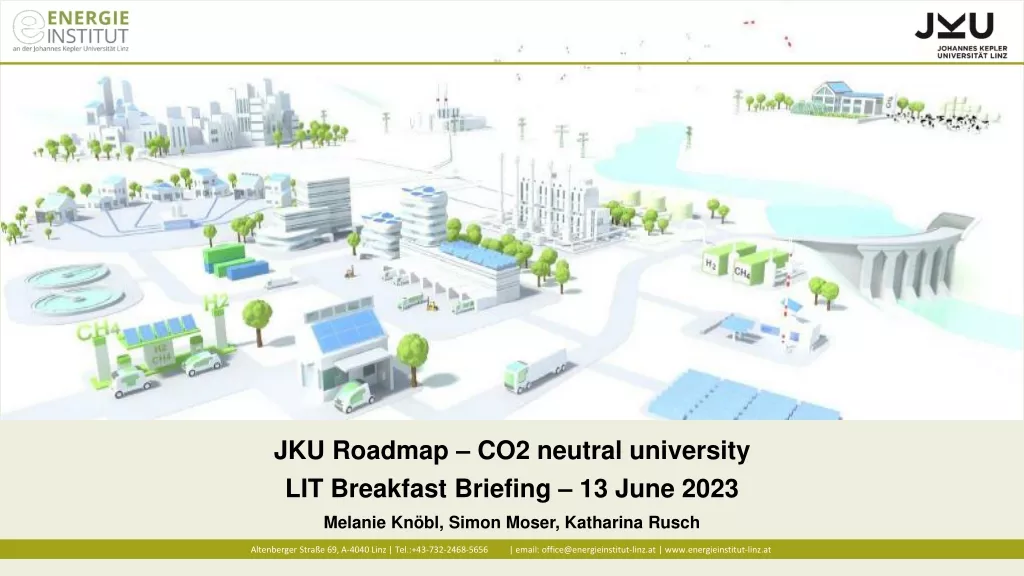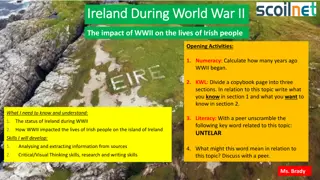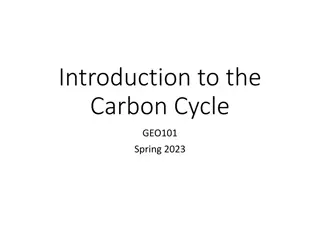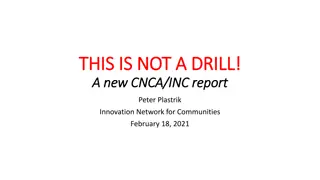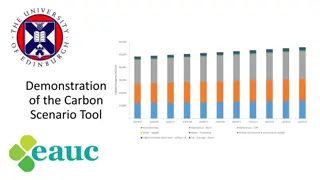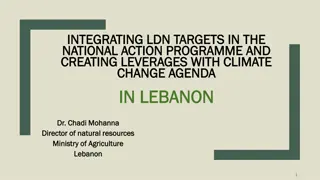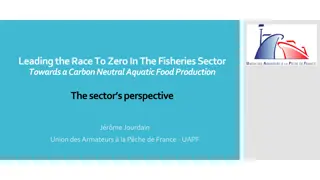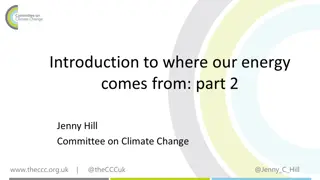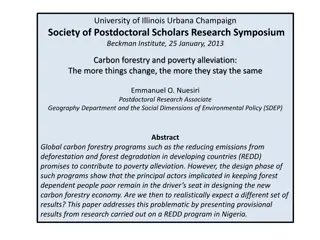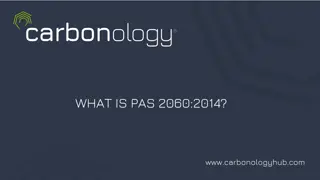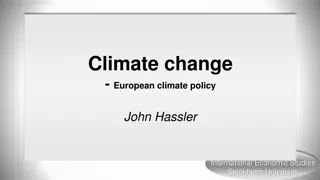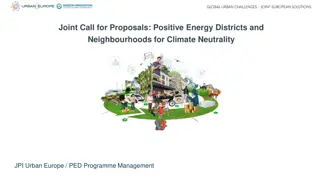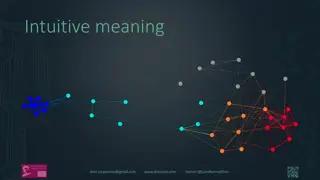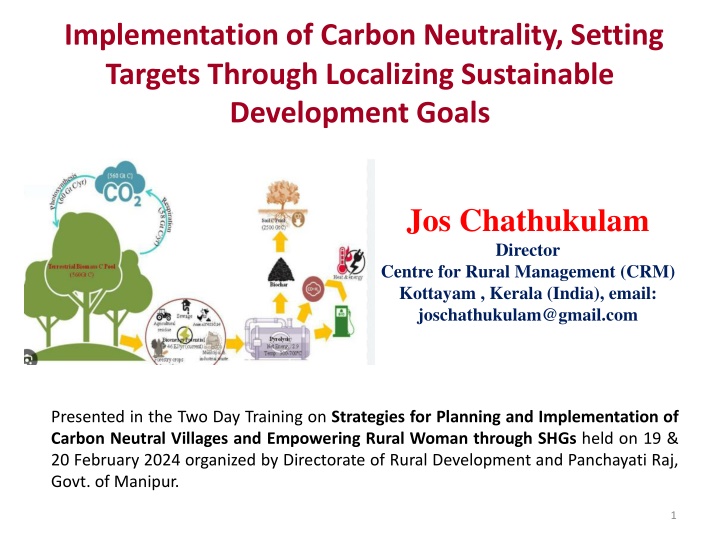
Implementation of Carbon Neutrality, Setting Targets Through Localizing Sustainable Development Goals
Carbon neutrality initiatives in India are being driven by the localization of Sustainable Development Goals (SDGs). This involves translating SDG goals into local policies to ensure success. NITI Aayog's efforts in coordinating and monitoring SDGs at the state and district levels are discussed, along with the importance of empowering local governments for effective localization.
Download Presentation

Please find below an Image/Link to download the presentation.
The content on the website is provided AS IS for your information and personal use only. It may not be sold, licensed, or shared on other websites without obtaining consent from the author. If you encounter any issues during the download, it is possible that the publisher has removed the file from their server.
You are allowed to download the files provided on this website for personal or commercial use, subject to the condition that they are used lawfully. All files are the property of their respective owners.
The content on the website is provided AS IS for your information and personal use only. It may not be sold, licensed, or shared on other websites without obtaining consent from the author.
E N D
Presentation Transcript
Implementation of Carbon Neutrality, Setting Targets Through Localizing Sustainable Development Goals Jos Chathukulam Director Centre for Rural Management (CRM) Kottayam , Kerala (India), email: joschathukulam@gmail.com Presented in the Two Day Training on Strategies for Planning and Implementation of Carbon Neutral Villages and Empowering Rural Woman through SHGs held on 19 & 20 February 2024 organized by Directorate of Rural Development and Panchayati Raj, Govt. of Manipur. 1
SDGs & India SDGs are prescribed as the answer to address the development challenges in various countries including India. India is a signatory of SDGs 2030 and has offered its strong commitment. Flagship Programmes and National Development Goals are reflected in SDGs. For instance, the flagship programs of the Government of India such as National Nutrition Mission, National Health Protection Scheme, Care for the Girl Child, and Aspirational Districts Programme have the potential to address the challenges highlighted by SDGs. Then centrally sponsored schemes including MGNREGS are directly or indirectly aligned with SDGs. Moreover, the Sabka Saath, Sabka Vikas, Sabka Vishwas , mirror the essence of the 2030 Agenda for Sustainable Development. With the Principle of Cooperative Federalism, the states are the primary stakeholders in ensuring the success of localization of SDGs Localization of SDGs is of central importance in ensuring the success of carbon neutrality initiatives. For this, the SDG goals need to be translated into policies at local level. 2
Attempts to Localize SDGs in India A.The Attempts by NITI Aayog in Localizing SDGs NITI Aayog is the Nodal Agency for coordinating and monitoring the SDGs in India. NITI Aayog periodically conducts reviews on SDG adoption and reaches out to the States and UTs. In 2018, NITI Aayog released SDG India Index: Baseline Report 2018. The SDG India Index is a single measurable Index to map progress of States & UTs towards 2030 SDGs. It documents the progress made by the States and UTs towards implementing the 2030 SDG targets. In 2019, NITI Aayog published a report on Localizing SDGs, Early Lessons from 2019. 3
Attempts to Localize SDGs in India A Critique of NITI Aayog s Approach in Localizing of SDGs For NITI Aayog, localization in terms of SDGs refer to as a process of recognising sub-national contexts. NITI Aayog asserts that sub-national governments especially those at State play an important role. Based on the SDG India Index: Baseline Report 2018 and the Localizing SDGs, Early Lessons from 2019, NITI Aayog s focus on localization is limited to States/ UTs and to some extent at the district level. It only offers limited attention on the significance of localization of SDGs at grassroots level. No evaluation and assessment on the present status and performance of localizing SDGs at the grassroots level has been attempted. There are only passive references to localization of SDGs at Grassroots Level involving Local Governments . NITI Aayog s focus is largely on sub-national governments rather than Local Governments. 4
Attempts to Localize SDGs in India The Attempts by the MoPR in Localizing SDGs Empowering Local Governments is one of the solid strategies for ensuring community ownership, integration and localization of SDGs at grassroots level, primarily due to the fact that the members are directly elected by the people, and are mandated to undertake planning exercise for social justice and local economic development in consultation with the people. 29 Subjects that are assigned to Gram Panchayats cover the SDGs. Many of the SDG targets are within the purview of these functions listed in the 11thSchedule. There are also the various flagship programmes such as Swachh Bharat Abhiyan and Jan Dhan Yojana which are at the core of the SDGs. Local governments play a pivotal role in many of these programmes. MoPR has been advocating to integrate SDGs with GPDP and have started to prepare guidelines to support this integration. 5
Attempts to Localize SDGs in India The Attempts by the MoPR in Localizing SDGs The GPDPs are prepared in a participatory manner and needs to be approved by the Gram Sabhas. Thus, integrating SDGs into GPDP is an important step in localizing SDGs at the grassroots level. The GPDP process supported by the MoPR has created conducive conditions for the Gram Panchayats to integrate SDGs into development action . MoPR is committed to the achievement of SDG goals through Rashtriya Gram Swaraj Abhiyan (RGSA). 6
Attempts to Localize SDGs in India The Attempts by the MoPR in Localizing SDGs Among the 17 SDGs, MoPR has identified 13 Goals where it could intervene at the grassroots level. Those selected SDGs are: Goal 1 NO POVERTY Goal 2 - ZERO HUNGER Goal 3 - GOOD HEALTH AND WELL BEING Goal 4 - QUALITY EDUCATION Goal 5 - GENDER EQUALITY Goal 6 - CLEAN WATER AND SANITATION Goal 7 - CLEAN AND AFFORDABLE ENERGY Goal 8 - DECENT WORK AND ECONOMIC GROWTH Goal 10 - REDUCED INEQUALITIES Goal 13 - CLIMATE ACTION Goal 14 - LIFE BELOW WATER Goal 15 - LIFE ON LAND GOAL 16 - PEACE JUSTICE AND STRONG INSTITUTION 7
Attempts to Localize SDGs in India The Attempts by the MoPR in Localizing SDGs MoPR has constituted an Expert Group in 2020 to provide recommendations and way forward for localizing SDGs through PRIs. The Expert Group has prepared a Report on Localization of SDGs in PRIs. It acts as a blueprint to understand how SDGs can be localized to engage PRIs . It provides a framework for localizing the implementation of SDGs through capacitating local governments. The Report aims at empowering local governments to plan, monitor and implement SDGs. 8
Attempts to Localize SDGs in Kerala Capacity Building for Localizing SDGs by KILA KILA has been undertaking CB&T for multiple stakeholders on SDGs by including a module on SDGs on Social Education Programme . KILA, has been designated as the CB&T partner on SDGs and has setup the Centre for SDGs and Local Governments . It has prepared a draft Local Indicator Framework (LIF) incorporating 16 SDGs and its Sub- Indicators. KILA has prepared an Online Dashboard, on the attainment of SDGs. KILA has developed SDG Training Tool Kit for setting targets and monitoring SDGs that enable the functionaries at district and sub-district levels to track and monitor the progress on SDGs. 9
Attempts to Localize SDGs in Kerala Localizing SDGs and 25 Years of Experience in Planning and Decentralization (PPC) Kerala which has 25 years of experience in planning and decentralization affords the best opportunity for Localizing SDGs. 10
Localizing SDGs with Specific Emphasis to Carbon Neutrality Discussing case studies on localizing SDGs in 2 Gram Panchayats in Kerala Chelakkara GP in Thrissur district and Nellanad GP in Thiruvanthapuram district. Examines the experimentations undertaken in localizing SDGs in these 2 GPs from a theoretical perspective of Gandhi-Kumarappa framework on the political economy of development and environment. 11
Localizing SDGs and The Case of 2 GPs in Kerala Case Studies Chelakkara GP Nellanad GP 12
Nellanad Gram Panchayat Basic Statistics Total Population No. of Elected Functionaries 16 Households Head of the Panchayat OSR (2021-2022) Receipts (2021-22) Payments (2021-22) Total Projects (2022-23) Plan Size (2022-23) Present Political Regime 26000 6585 Women Rs 1.9 Crore Rs.16.34 Crore Rs.10.89 Crore 154 Rs.12.03 Crore Congress (UDF Coalition) 13
Linking with the SDGs Organized training, awareness programmes , campaigns for the office bearers and elected functionaries and local citizens. KILA has provided full support and mentoring . Local Indicator Framework operationalized. Has formulated a new vision for preparing the targets and linking with the SDGs. Prepared a vision document to implement 6 key programmes in tune with the SDGs with a common tagline - Nellanad Nalla Nadu ( Nellanad a Land of Wellbeing)&No such tagline for Chelakkara GP. workshops, consultations, (LIF) has 14
Nellanad Gram Panchayat Programme I- Malinya Muktha Nellanad (Solid Waste and Liquid Waste Free Nellanad) SDG 6 and SDG 13 are closely linked to carbon-neutrality 15
Nellanad Gram Panchayat Programme II- (Comprehensive Watershed Development) 16
Nellanad Gram Panchayat Programme III-VIDYA VELICHAM (Enlightenment through Education) 17
Nellanad Gram Panchayat Programme IVa- Panchayat Level Sahitya Academy-(Literary & Cultural Forum) 18
Nellanad Gram Panchayat Programme IVb- Panchayat Sports Council 19
Nellanad Gram Panchayat Programme V- Labour Hub- (An Employment Platform) 20
Nellanad Gram Panchayat Programme VI- THANAL-(Shadow for Senior Citizens) 21
Chelakkara Gram Panchayat Basic Statistics Total Population No. of Elected Functionaries Households Head of the Panchayat OSR (2020-21) Receipts(2020-21) Payments (2020-21) Total Projects (2022-23) Plan Size (2022-23) Present Political Regime (2022-23) CPI(M) (LDF Coalition) 44389 22 11115 Women Rs.1.54 Crores Rs.14.85 Crore Rs.7.47 Crore 154 Rs.13.50 Crore 22
Chelakkara Gram Panchayat Programme I- Health for All 23
Chelakkara Gram Panchayat Programme II- Energy for Solar Panel Here SDG 7 and SDG 13 are closely linked to carbon neutrality 24
Chelakkara Gram Panchayat Programme III- Malinya Muktha Chelakkara ( Solid & Liquide Waste Free Chelakkara ) 25
Chelakkara Gram Panchayat Programme IV- Fitness Centre for Women 26
Chelakkara Gram Panchayat Programme V- Mini Industrial Estate 27
Chelakkara Gram Panchayat Programme VI- Child Friendly Panchayat 28
Chelakkara Gram Panchayat Programme VII- Protection of Water Bodies 29
NET ZERO CARBON SAMPLE SURVEY FORM Net Zero Carbon SurveyForm-1 Government/Semi-Government, Public Institutions, Co-Operative Institutions Serial number Date Name of the District Name of the local Government Type of the local Government Gram Panchayat, Municipality, Municipal Corporation Name and Number of the Ward/Division
NET ZERO CARBON SAMPLE SURVEY FORM Net Zero Carbon Survey ForumForm-1 1. General Information of the Institution Name of the Institutions Post Office, Pin Code Type of Activity Number of Employees Area Building Area(Meter Squre) Area of the Land (In Cent) Total Number of Buildings
NET ZERO CARBON SAMPLE SURVEY FORM Net Zero Carbon Survey ForumForm-1 2. Energy KSEBL Consumer No. Last Electricity Bill (If last bimonthly bill available) Last bimonthly bill (In Rs) Is there a solar Plant If yes, Capacity of the Plant (Kw) Yes/No
NET ZERO CARBON SAMPLE SURVEY FORM Net Zero Carbon Survey Form-1 3. Information on the Other Sources of Energy Use of Fire Wood per month (Kg) Use of LPG per month(Number of Cylinder) Any Other Use of Bio gas per month ( hour) Use of induction cooker per month (hour) Any Other
NET ZERO CARBON SAMPLE SURVEY FORM Net Zero Carbon Survey Form-1 a. Bulbs/Tube lights No. Type Capacity(watt) Daily use time(hour)
NET ZERO CARBON SAMPLE SURVEY FORM Net Zero Carbon Survey Form-1 b. Fan No. Type Capacity(watt) Daily use time(hour)
NET ZERO CARBON SAMPLE SURVEY FORM Net Zero Carbon Survey Form-1 c. Refrigerator No. Type Capacity(watt) Daily use time(hour)
NET ZERO CARBON SAMPLE SURVEY FORM Net Zero Carbon Survey Form-1 d. Air Condition No. Type Capacity(watt) Daily use time(hour)
NET ZERO CARBON SAMPLE SURVEY FORM Net Zero Carbon Survey Form-1 e. Other Instruments No. Type Capacity(watt) Daily use time(hour)
NET ZERO CARBON SAMPLE SURVEY FORM Net Zero Carbon - Survey Form-1 4.Waste Does garbage/waste pile up within the institutional premises? Is there a landfill site? If yes, please specify the size of the area used as a landfill (in Cents) Average height of the waste deposit (in centimeters) Have you come across incidents where the dumped waste was found burned? Is there a bio gas plant? If yes, please specify the quantity of waste deposited per day Yes No
NET ZERO CARBON SAMPLE SURVEY FORM Net Zero Carbon Survey Form-1 a. Information on type of waste and waste treatment/processing methods Type Waste per day (Kilogram) Processing method Organic Dumped Composting Converted into Bio gas Burning Dumped Segregate Non organic
NET ZERO CARBON SAMPLE SURVEY FORM Net Zero CarbonSurvey - Form-1 5. Water Consumption Yes No Have you noticed wastage/leakage of water from taps/pipes? Have you noticed any leaks in taps and water supply systems? Yes No Overhead water tank Capacity(Liter) Method of filling the water(Use tick mark) Municipal water fills the overhead tank Well/Bore well/ Pumping from the lower tank Pump Capacity (HP) If using municipal water Bimonthly usage (kilo liter) Bimonthly water bill (in Rs) Tank filling time (Minute)
NET ZERO CARBON SAMPLE SURVEY FORM Net Zero CarbonSurvey - Form-1 5. Transportation a. Does your institution have its own vehicle? Yes No b. If Yes, please specify the details on the vehicle Details of the Vehicle Sl No. Information on fuel used Diesel No. Average quantity of fuel used per month(Litre) Type of vehicle Petrol No. CNG No. Electricity No. Average quantity of fuel used per month(Litr e) Average quantity of fuel used per month(Kg) Average distanc e travele d per month (Km
NET ZERO CARBON SAMPLE SURVEY FORM Net Zero CarbonSurvey - Form-1 c. Information Regarding Vehicles Used by Employees Details of the Vehicle Sl No. Information on fuel used Diesel No. Average quantity of fuel used per month(Litre ) Type of vehicle Petrol No. CNG No. Electricity No. Average quantity of fuel used per month(Li tre) Average quantity of fuel used per month(K g) Averag e distan ce travele d per month (Km)
NET ZERO CARBON SAMPLE SURVEY FORM Net Zero CarbonSurvey - Form-1 6. Agriculture Do you have any type of farming or cultivation on the Institute premises? Yes No If Yes, please provide the details below Details of location (Wetland, Terrace, dry land) Area (Cent) Cultivated crops Quantity of fertilizer used (in kg for a year) Fertilizer Organic fertilizer
NET ZERO CARBON SAMPLE SURVEY FORM Net Zero CarbonSurvey - Form-1 7. Other Details Any Green Spaces/Corners established in your Institution If Yes, please specify, the area allocated for the green spaces? Total number of plants When was the Green Spaces established? Is there a garden? Area of the Garden (Cent) Is there agricultural land? Yes No Yes No Yes No
NET ZERO CARBON EMISSION ESTIMATION SURVEY FORM Public Places Serial number Date Name of the District Name of the local Government Type of the local Government Gram Panchayat, Municipality, Municipal Corporation Name and Number of the Ward/Division
NET ZERO CARBON EMISSION ESTIMATION SURVEY FORM 1. Agriculture (Paddy Fields) Name of the Place Land Mark Ownership of agricultural land Private, Government/Public Sector, Co-Operative Name of the Owner Type of Land Total area of the Land(Cent) Area of land under cultivation Area of cultivable fallow land How many years the land has been barren? Wet Land Dry Land
NET ZERO CARBON EMISSION ESTIMATION SURVEY FORM 1. (a) Details of the crop cultivated Crop Area(Ce nt) Cultivati on Period Fertilization method Pest control method Fully agro- farming Fully chemica l fertilizer Applicat ion of mixed fertilizer Organic pest control method Chemica l pest control method Paddy Have you noticed any incidents were garbage/waste was dumped on agricultural land? Is there any landfill? If yes, please give the details regarding its area (in Cents) Average height of the waste deposit /dumped waste (in Centimeters) Have you come across any incidents where crop residuals were burned? Yes No
NET ZERO CARBON EMISSION ESTIMATION SURVEY FORM 2. Waste Disposal Centers Place Total Area of the Waste Disposal Centers (in Cents) Average Height of the deposited Waste (In Centimeters) Type of waste deposited Organic Non-Organic Not Segregated segregate 2 (a). Quantity of the Waste Generated and Waste Treatment Method Type Organic Waste per day(Kilogram) Processing method Dumped Composting Converted into Bio gas Burning Dumped Segregate Non organic
NET ZERO CARBON EMISSION ESTIMATION SURVEY FORM 3. Bus Auto Taxi Other Vehicle ( ..) Stand Name of the place where the Bus/Auto/Taxi stand is located 3. (a). Type of Vehicles and Fuels Used Details of the Vehicle Sl No. Information on fuel used Diesel No. Average quantity of fuel used per month(Litre ) Type of vehicle Petrol No. CNG No. Electricity No. Average quantity of fuel used per month(Li tre) Average quantity of fuel used per month(K g) Averag e distan ce travele d per month (Km




